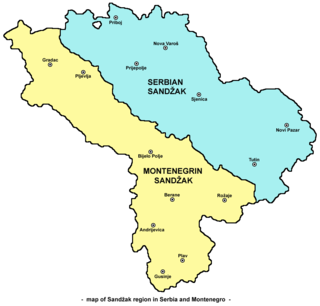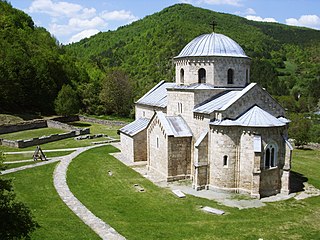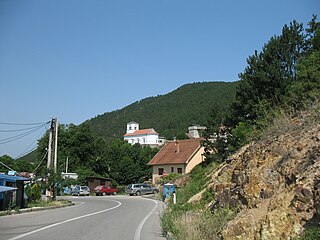
Sandžak is a historical geo-political region located in the southwestern part of Serbia and the eastern part of Montenegro. The name Sandžak derives from the Sanjak of Novi Pazar, a former Ottoman administrative district founded in 1865.

Gradac ; Italian: Labinezza), is a municipality in southern Dalmatia, Croatia. It is situated halfway between Split and Dubrovnik. The town of Ploče is 12 km south of Gradac, while the town of Makarska is 42 km north.

The Pešter Plateau, or simply Pešter, is a karst plateau in southwestern Serbia, in the Raška region.

Shkreli is a historical Albanian tribe and region in the Malësia Madhe region of northern Albania and is majority Catholic. With the expansion of the Ottoman Empire, part of the tribe migrated to Rugova in Western Kosovo beginning around 1700, after which they continued to migrate into the Lower Pešter and Sandžak regions.

Old Montenegro, also known as Montenegro proper, or True Montenegro, is a term used for the embryonic part of modern Montenegro. In historical context, the term designates the original territory of the Principality of Montenegro, before the territorial expansion, ratified by the Congress of Berlin in 1878, or even more precisely - the territory of the Prince-Bishopric of Montenegro prior to its unification with the region of Brda in the first half of the 19th century.

The Gradac Monastery is an endowment of queen Helen which was built from 1277 to 1282 during the reign of her son king Stefan Dragutin. It lies on the elevated plateau above the river Gradačka, at the edge of the forested slopes Golija. Gradac Monastery was declared Monument of Culture of Exceptional Importance in 1979, and it is protected by Serbia.

Gradac is a village in the municipality of Batočina, Serbia. According to the 2011 census, the village has a population of 206 people. The Gradac Cave located in the village is part of the Cultural Heritage of Serbia list, inscribed in 1979.
Đake is a village in the municipality of Kuršumlija, Serbia. According to the 2002 census, the village has a population of 83 people.
Dedinac is a village in the municipality of Kuršumlija, Serbia. According to the 2002 census, the village has a population of 124 people.
Selište is a village in the municipality of Kuršumlija, Serbia. According to the 2002 census, the village has a population of 24 people.
Kaludra is a village in the municipality of Prokuplje, Serbia. According to the 2002 census, the village has a population of 80 people.
Gradac is a village in the municipality of Brus, Serbia. According to the 2002 census, the village has a population of 134 people.
Gradac is a village in the municipality of Ivanjica, Serbia. According to the 2011 census, the village has a population of 73 inhabitants. The village is home to the Cross of Gradac, a large stone cross erected in 1662 that served as a village record.
Gradac is a village in the municipality of Sjenica, Serbia. According to the 2002 census, the village has a population of 150 people.

Boroštica is a village in the municipality of Tutin, Serbia. According to the 2002 census, the village has a population of 379 people.
Koniče is a village in the municipality of Tutin, Serbia. According to the 2002 census, the village has a population of 322 people.

Melaje is a village in the municipality of Tutin, Serbia. According to the 2002 census, the village has a population of 431 people.
Raduša is a village in the municipality of Tutin, Serbia. According to the 2002 census, the village has a population of 90 people.

Gradac is a village in the municipality of Raška, Serbia. According to the 2002 census, the village has a population of 368 people.

Rudnica is a village in the municipality of Raška, Serbia.











